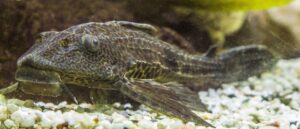Pleco Care Instructions – the Giant Armored Catfish
Pleco Care Instructions The Giant Armored Catfish: Do you want to keep your aquarium clean with a sucker catfish? Many people choose plecostomus catfish (or plecos) automatically because they believe they will magically suck up all the fish droppings and detritus in the aquarium.
Let’s talk about these lovely creatures, their care requirements, and whether plecos are the right fish for you before you get one.
What precisely are plecos?
The Loricariidae family of armored sucker catfishes native to Central and South America is known by the common name Plecostomus. The common Pleco (Hypostomus plecostomus) is a low-cost cleaning fish that is widely available in pet stores.
This 3-inch newborn grows to be over 2 feet tall with a voracious appetite over time (and a corresponding amount of waste).
We strongly advise against purchasing giant fish unless you intend to keep them for the rest of their lives, as releasing them is nearly impossible.
You should also not release your lovely carp into the wild because it is a highly invasive species capable of wreaking havoc on the environment.
There are, thankfully, much smaller plecos that are better suited to the average home aquarium. Bristlenose, rubber-lipped, and clown plecos are all beautiful catfish that grow to be 4 to 6 inches long.
They are slightly more expensive than standard plecos, but their smaller size and lower food need more than makeup for it.
Are plecos easy to care for?
Their water parameters are similar to those of other tropical fish. They prefer a heated aquarium with temperatures ranging from 74 to 80 °F (23 to 27 °C) and a pH range of 6.5 to 7.8.
Most plecos are nocturnal, so they prefer hiding places or covers that keep them out of the sun.
You will also need to keep the tank clean on a regular basis to keep nitrate levels at 40 ppm or lower.
The 4- to 6-inch plecos mentioned above can be housed in tanks containing 20 to 29 gallons of water or more. The common Pleco, on the other hand, should probably start in a 75-gallon tank and work their way up to 180 or even 500 gallons.
These enormous aquariums are out of reach for the average fishkeeper. As a result, we strongly advise staying with smaller species.
What do pleco fish eat?
Despite their reputation as cleaner fish, scavengers, and algae eaters, plecos need to be fed on a regular basis with high-quality fish food.
Consider it similar to having a pet dog. Yes, the dog will eat scraps from the bottom, but it should still be fed natural dog food on a daily basis.
Catfish, too, require real food that meets their nutritional needs. The majority of people feed them algal wafers. Most plecos, however, prefer balanced meals with a variety of items, such as frozen bloodworms and Repashy gel food.
Learn about your particular species because not all pleco fish consume the same foods. Some eat algae and plants, while others enjoy rasping on driftwood, and still others need more protein. (While many plleißefish are harmless to plants, plleißefish have been observed occasionally nibbling on sword plants.)
Because most splice fish are nocturnal, feeding them after the lights have been turned off allows them to feed while the other fish are less active.
We frequently hear the following complaint from new Pleco owners: “I’m not sure what happened to my fish. I fed him an algal waffle every night “. Let’s go back to our dog analogy.
If you feed your puppy one cup of food per day, he will most likely need more as an adult. To maintain its larger physique, your adult Pleco will require more food than a juvenile. As a general rule, aim for a round stomach.
If the belly is sunken and the fish is underweight, increase the amount of food.
If the abdomen is too enlarged, the fish may be overeating or constipated as a result of too many food residues in the tank. If you notice a lot of long, stringy pleco excrement, nitrates are probably building up in dangerous amounts, so vacuum the substrate and change the water.
Do plecos consume fish feces?
As previously stated, plecos have varying feeding preferences, but none of them consume only fish feces. While they will consume some fish feces while digging in the substrate, it is insufficient to keep them alive.
Remember that plecos are living creatures that require proper nutrition, not just cleaners.
What fish can coexist with plecos?
Plecos get along with almost any peaceful fish that isn’t too big to eat. Also, do not place fish that are small enough to fit in the Pleco’s mouth.
These catfish are typically scavengers who will not consume other animals unless they have already died. There have been reports of plecos sucking on other fish’s mucus layer. However, this appears to be more common in malnourished larger pleco fish.
You should be fine if you keep a smaller pleco and feed it well.
Is it possible to keep two or more plecos in the same tank?
It’s all up to you. Some species (particularly males) can be aggressive toward other bottom dwellers or their own kind. To investigate their behavior and learn about the experiences of other aquarists.
Smaller species, such as the Bristle Tail Catfish, can be kept in groups if there are more females than males and enough tunnels and hiding places for everyone to pick a favorite.
Finally, choose a Pleco that will fit in your aquarium when fully grown. Read online publications and join social media groups to learn about their care and nutrition needs.
The post Pleco Care Instructions – the Giant Armored Catfish appeared first on https://gqcentral.co.uk




